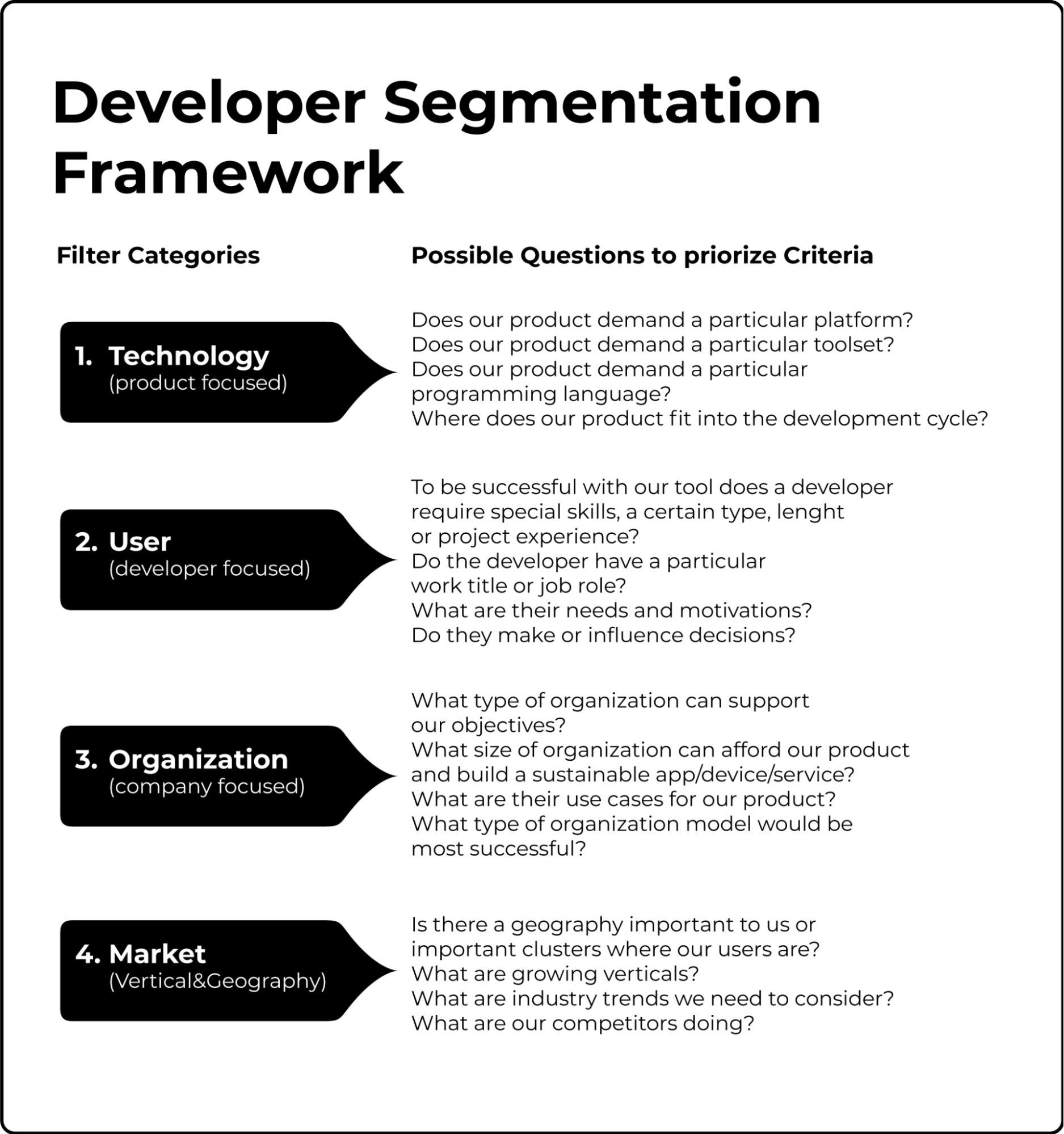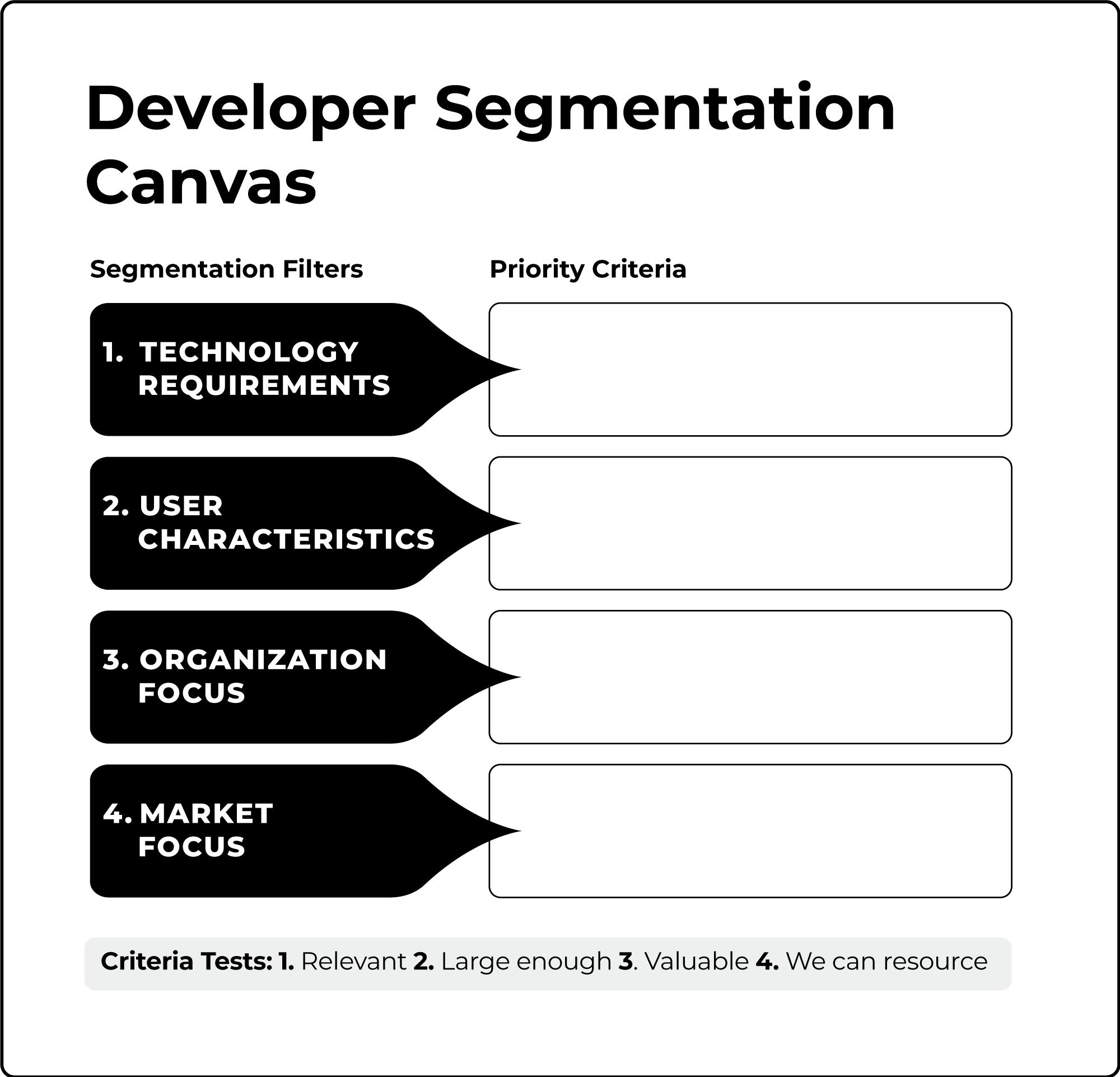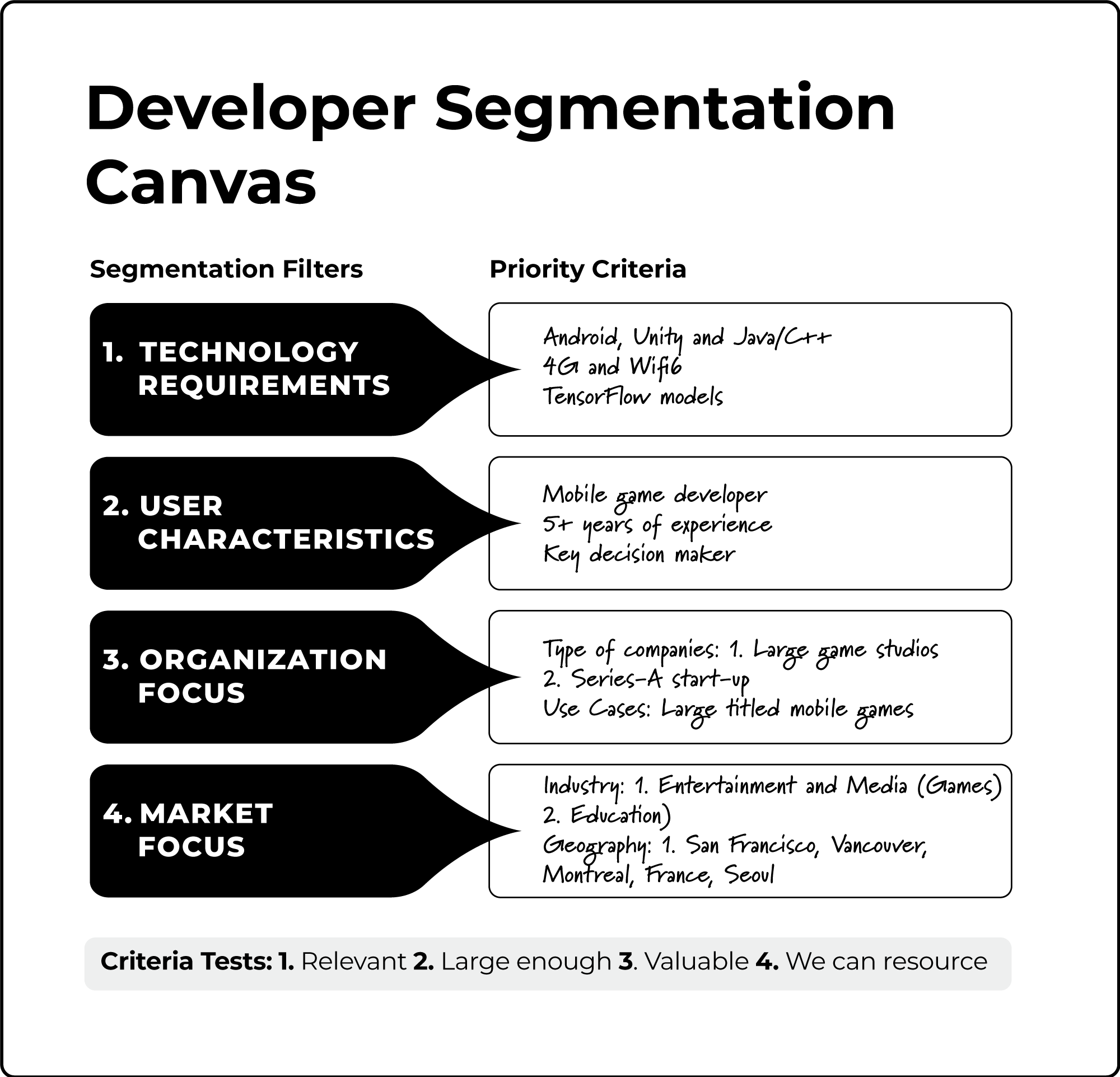You’re Targeting Developers? So Is Everyone Else. Here’s How to Do Segmentation Better.
Caroline Lewko is an accomplished visionary and entrepreneur who has spent over two decades helping develop groundbreaking technology and nurturing community connections and innovation. As CEO of Revere Communications, she focuses on training and mentoring the next generation of DevRel leaders. In this post, Caroline shares an excerpt from her book, co-written with James Parton, Developer Relations: How to Build and Grow a Successful Developer Program.
One sure way to make me grimace is to tell me you are “targeting developers,” or better yet, you’re “targeting the long tail.” Even saying “we’re targeting enterprise developers,” will raise an eyebrow. You are setting yourself up to fail.
Here’s why. There is no simple single definition for ‘Developer.’ Rather, it refers to millions of people with differing skill levels and authority, who use different technology stacks and programming languages. They speak different languages and live in different geographic regions. They belong to different types of companies, are at different stages of their education or professional career, and are working on different use cases. The sheer variety of traits that make each developer unique, quickly adds to a combinatorial explosion of attributes that create colossal diversity.
Because of this diversity, you can’t expect the same message to resonate with them all. You can’t expect to find them all in the same place. Nor do they all want or need your product.
At the same time, your product was likely designed for a specific audience. It’s not effective or necessary for you to target ‘all developers’, and you likely don’t have the resources to attempt such a feat even if you wanted to.
Segmentation is about focus and alignment
That’s where Segmentation comes in. Focus is required because the alternative is unrealistic. To succeed, you must pursue targeted opportunities rather than the entire market.
By creating your segments (or target groups), and subsequently developer personas, you will be able to:
- Make your messaging more precise and tailored
- Create a smarter go-to-market strategy
- Use it to optimize your Developer Experience
- Enhance your product
- Nail down your product/market fit, and
- Decide on the type of support to offer.
There are a number of criteria to understand about developers including:
- Their motivation – why do they do what they do?
- Their skillset – what tools and resources do they currently use, what gaps do they have?
- Their goals – what do they want to achieve?
- Their mindset – how do they evaluate and make decisions?
- The demands on their time – where and how do they need support? What type of projects are they working on?
- Their limiting factors – skills, budget, existing infrastructure choices, corporate culture?
- The demands on their attention – who are you competing with for mindshare?
- And where to find them?
Segmentation isn’t just about your target audience. To be successful, segmentation must also consider your company and Developer Program goals and objectives, as well as the product you are supporting.
We’ve used and reviewed many segmentation models over the years, but always found them lacking effectiveness for Developer Relations. Other segmentation frameworks tend to not work for DevRel because:
- They aren’t practical enough.
- They aren’t specific enough to YOUR business and product.
- They only go part way (using only a single filter or just demographic data).
- They don’t give you enough information to target your developer audience and plan a tactical strategy adequately.
- They don’t map to the real world – Developers don’t identify with them.
They also failed to answer a basic segmentation question: What type of developer will find success with our product?
So we created a segmentation strategy and framework specific to Developer Relations to help you focus your target audience in an easier and more transparent way. The Developer Segmentation Framework, as shown below in Figure 1, has proven effective time and time again over the last decade.
Developer Segmentation Framework
To start your segmentation you’ll gather several sources of information. This will include qualitative sources like feedback from your community, colleagues, and peers in the industry and the tech press. If you have an existing community, gather information from your CRM and product analytics tools. It may also include quantitative data from reports and surveys like those published by Stack Overflow, SlashData, or your own community surveys.
You’ll see the framework uses a series of four filters to help you narrow down the criteria in which you will segment your developer targets:
- Technical (product focused)
- User (developer focused)
- Organization (customer organization/use-case focused)
- Market (industry vertical and geography focused)

Figure 1. Developer Segmentation Framework
There are several questions for you to answer in each filter category. You may also add others and adapt it to what makes sense for you. Think about what is important for your product and company right now. You may not have criteria for each category, and the relevance will vary from product to product, and company to company.
Segmentation Criteria Tests
As you list your criteria by answering the questions in the framework, your criteria must also be able to answer “YES” for each of these tests:
- Is the segment relevant to our business?
- Is it a large enough segment?
- Is it a valuable enough segment?
- Can we target this segment based on our resources?
This Developer Segmentation Canvas can be used to fill in your criteria. You can download one on GitHub.

Figure 2. Developer Segmentation Canvas
If you’ve listed more than 2 or 3 criteria in a particular category, we suggest you rank them. Then plan your strategy and activities with those ranked most important first.
Developer Segmentation Canvas in Action
We thought it would be helpful if we walked you through an example of completing a segmentation canvas. For this example we will use a never-before-seen developer SDK, that helps mobile game developers utilize artificial intelligence (AI) to create real-time immersive environments in their games.
We want to answer the question: What type of developer will find success with our product? Let’s go through each filter to identify the best criteria.
1. Technical
This product is only focused on the Android mobile operating platform and also integrates with Unity. Developers can use Java or C++ programming languages for the integration of our tool. The implementation takes place after the game has been designed, and builds on top of Android's Telecom Framework, so the developer should have some understanding of telecommunications protocols. It includes a number of pre-trained TensorFlow models for generative imagery at the edge.
Our Technical criteria is: Android, Unity and Java/C++, 4G and Wifi6, TensorFlow models
2. User
The implementation of our SDK is fairly complex, so we would expect the developer to have around 5 years of mobile gaming development experience. This is a crucial technology for a game, so we would expect our developers to have the knowledge and authority to make the decision to adopt our SDK.
Our user criteria is: Mobile game developer, 5+ years of experience, Key decision makers.
3. Organization
These complex types of games and technology are likely created by big game studios, however, it is likely that a well-funded Series-A start-up with experienced developers may also be motivated to attempt this type of game.
Our organization criteria is: Companies that would be most successful with this type of game are 1. Large game studios 2. Series-A start-up. Their use cases are creating large branded mobile games.
4. Market
The industry for our product is Entertainment and Media, notably games. However, we have seen the Education market, specifically because of the school-from-home trend, become more interested in these types of mixed-reality apps. Regionally, the larger game companies are based in the USA (San Francisco), Canada (Vancouver and Montreal), France, and South Korea. It makes the most sense to start with our home market of San Francisco for education, where our CEO is connected.
Our Market criteria is: Industry 1. Entertainment and Media (Games) 2. Education. Geography – San Francisco, Vancouver, Montreal, France, Seoul.
Below in Figure 3, we have completed a segmentation canvas for you based on our filtering exercise above:

Figure 3. Example of a completed developer segmentation
With your segmentation complete, the insight it provides will be used to develop personas to create effective strategies and activities for your developer audiences.
Segmentation is not a one-time exercise. To start, it’s most important to focus on your current situation over the next 6 to 12 months. However, what’s important today may change in the future, as the market changes (e.g., new entrants, developers' experience), or your situation changes (e.g., updates to your product or business objectives). You may also find alternative criteria based on your own users who start using your product.
Summary
With such breadth and diversity across the entire Developer community, your product is highly unlikely to appeal to everyone, and even if you wanted to, you will not have enough resources to reach so many people and be effective.
Whether you're a Developer-First or Developer-Plus company, segmentation is a crucial exercise. Use it to focuses your target audience while keeping in mind the goals and resources of your company. The exercise also sets you up for creating your target Developer persona’s which bring your segments to life.
Interested in learning more? Pick up a copy of Developer Relations: How to Build and Grow a Successful Developer Program for a deep dive on DevRel and access valuable templates to operationalize your developer-led strategy.
Subscribe to Heavybit Updates
You don’t have to build on your own. We help you stay ahead with the hottest resources, latest product updates, and top job opportunities from the community. Don’t miss out—subscribe now.
Content from the Library
Sourcegraph's Quinn Slack on Founder Folklore
Sourcegraph CEO Quinn Slack argues that in the AI era, founders must abandon outdated playbooks, move radically faster, and stay...
Platform Builders Ep. #14, Navigating Restaurant Tech’s Roadmaps with Anthony Presley
On episode 14 of Platform Builders, Christine Spang and Isaac Nassimi speak with Anthony Presley. Anthony walks through his...
Platform Builders Ep. #11, How LLMs Are Changing PR Forever with Greg Galant
In episode 11 of Platform Builders, Christine Spang and Isaac Nassimi chat with Greg Galant. Greg recounts his early entrance...
